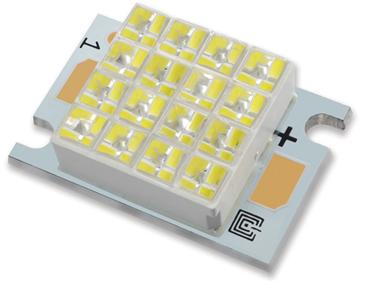A Bright Redesign for LED Lights
Illumitex, an LED-manufacturing company based in Austin, TX, launched its first product line earlier this month. The startup’s first LEDs are designed for general-purpose lighting and emit a uniform, narrow beam of white light that is almost two times brighter than any white LED on the market. The founders, all of whom have backgrounds in optics rather than solid-state lighting, achieved this by redesigning the package around the semiconductor chip that actually converts electricity into light.
Traditionally, LED manufacturers have enclosed the chips inside a dome in order to control the light output. Illumitex’s LEDs ship in a flat, square package that eliminates the cost and energy efficiency issues that come from using secondary optical lenses and reflectors. Cofounder and chief scientist Dung Tien Duong, who is the company’s primary inventor, won’t say much about how the unique package allows Illumitex engineers to extract more light from the LED dies, but he does say it takes “intuitive” advantage of physics principles. “If the chip is square, the light beam should be square,” he says. While the company is mum on the exact physics behind its achievements (patents are still pending), it has published data sheets for both its 16-die and 4-die LEDs, including some data verified by third-party testing companies.

Illumitex sells its packaged LEDs to companies that make LED-based light bulbs. CEO Matt Thomas says the startup already has several customers that sell products for outdoor lighting (e.g., streetlights) and commercial “high-bay” lighting (typical in warehouses or convention centers), as well as one company working on an LED replacement for the fluorescent tube lights usually found in offices. Only one customer is public at this time, Singapore-based LEDWorks, which has designed lighting for several famous casinos and hotels worldwide, as well as for the Singapore Flyer, the world’s largest Ferris wheel. Thomas says LEDWorks is incorporating the Illumitex LEDs into “a PAR30 replacement,” referring to the most popular floodlight-style bulbs used in indoor lighting, that could deliver 500 lumens for only 7 watts. A commercially available compact-fluorescent PAR30 bulb typically puts out 750 lumens of light at around 16 watts, while a halogen version might deliver 600 lumens for 50 watts of power.
Thomas says that in addition to their brightness and energy efficiency, Illumitex LEDs offer one advantage completely unique to its package design: the beam angle–that is, the angle at which light emerges from the package–can be tailored from 10° to 90° with limited light loss. This allows manufacturers to design systems that provide consistent, directed lighting without the dark spots or “spillover” typical of most lighting systems. For instance, picture a typical block of street lights: there are alternating bright and dark patches, and perhaps 25 percent or more the light “spills over” into the windows of homes and stores along the street. Although LEDs allow designers to direct the light, conventional domed LEDs still end up wasting a fair amount of energy on spillover. In contrast, Illumitex has created computer models that show its LEDs can be used to design a system that would provide consistent illumination along the sidewalk and street with only minimal spillover.

The company has pilot manufacturing facilities and extensive R&D and testing equipment in its south Austin office space. Full-scale manufacturing, however, is done in Asia. Though the actual LEDs in Illumitex’s first chips are “industry standard for white LEDs,” says Thomas, the company is extending its research beyond packaging and into actual LED design in its efforts to continue improving the efficiency of LEDs for general lighting.
Keep Reading
Most Popular
Large language models can do jaw-dropping things. But nobody knows exactly why.
And that's a problem. Figuring it out is one of the biggest scientific puzzles of our time and a crucial step towards controlling more powerful future models.
The problem with plug-in hybrids? Their drivers.
Plug-in hybrids are often sold as a transition to EVs, but new data from Europe shows we’re still underestimating the emissions they produce.
How scientists traced a mysterious covid case back to six toilets
When wastewater surveillance turns into a hunt for a single infected individual, the ethics get tricky.
Google DeepMind’s new generative model makes Super Mario–like games from scratch
Genie learns how to control games by watching hours and hours of video. It could help train next-gen robots too.
Stay connected
Get the latest updates from
MIT Technology Review
Discover special offers, top stories, upcoming events, and more.